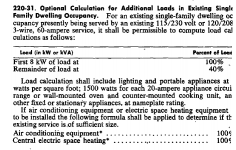wwhitney
Senior Member
- Location
- Berkeley, CA
- Occupation
- Retired
Why is 220.83(A) different from 220.83(B)?
It seems like when you are adding non-HVAC loads to a dwelling unit, 220.83(A) doesn't break out the A/C and electric space heating loads separately, so they end up lumped in with everything and with a 40% diversity factor. While 220.83(B) does break those loads out separately, and then gives them a 100% factor.
The upshot being that 220.83(A) would always give a lower number than 220.83(B). I can't see any technical justification for this distinction.
Thanks,
Wayne
It seems like when you are adding non-HVAC loads to a dwelling unit, 220.83(A) doesn't break out the A/C and electric space heating loads separately, so they end up lumped in with everything and with a 40% diversity factor. While 220.83(B) does break those loads out separately, and then gives them a 100% factor.
The upshot being that 220.83(A) would always give a lower number than 220.83(B). I can't see any technical justification for this distinction.
Thanks,
Wayne


